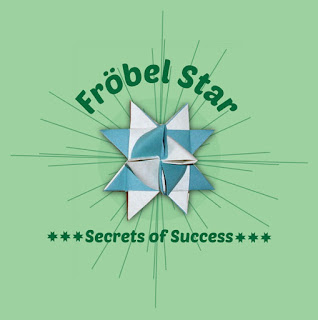The first thing in getting your head round Fröbels is to understand the operations involved in the making process. You will be doing three main things - setting up the weaving (like warping a loom), folding the 8 star points, and looping the cone-like projections.
So - although there appear to be lots of moves - it is " super-symmetry" - similar actions, done repeatedly. Star points x 8. Pointy cones x 4 (or 8). Not so daunting, after all!
Fröbel Star Prep - Make the Strips
* To facilitate weaving, trim both free strip ends into not-quite-points (above).
* It is important to used double-sided paper for Fröbel Stars. This is because the paper strips sometimes turn back on themselves when woven, revealing the flip side. So, for a consistent look, double-sided paper is required. Recommended papers: 90 gsm coloured paper, or Centura Pearl d/s. If you want to use prints - do it yourself. Print a piece of photocopier paper on both sides, then cut your strips. (Get the patterned paper design from a craft CD.)
Fröbel Star - Initial Weave
* The base weave is of four interlocking strips - much like those "seats" made of four grasped hands. Two strips each of two contrasting colours. The best beginner's set-up is like colours together. When interwoven, this produces a chequerboard, which helps you to see your "moves" clearly.
The diagram above shows you how to construct the Fröbel base weave. The top of the folded strip forms a loop through which tail ends are passed in pairs.
Okay. Base weave successfully completed. Now - eureka moment - the star is woven from two sides. You make four points on one side, then flip it over to complete the second four.
In order to weave the star points, you must create "weaving slots" through which to pass the working strip. This must be done on top of the base weave on each side of the base, prior to constructing the star points.
Here's how to make the weaving slots:
* Fold the weaving strips down consecutively, going clockwise. One, two, three, four. Secure the last strip by passing it through the weaving slot, as shown in the pic above.
You are now ready to construct the first batch of four star points. Each point is angled on the inside and straight on the outside.
* Pic above shows how to make the star points. Take a strip, fold it back to front to make the peaked triangle point. Fold the triangle point in half, swinging it to the centre of the woven base. Tip the triangle base backward to facilitate weaving. Passe the angled end of the weaving strip through the weaving slot. Your first star point is made!
Turn your weaving 90 degrees to make the next point - you now have a weaving slot facing the right direction. Make three more star points in the same way as the first.
* Sometimes it is necessary to lift a weaving strip to reveal the weaving slot.
* When the first four Fröbel Star points are constructed, flip the weaving over. You must now create the weaving slots on side two, as for part two of the intial set up. See pic below:
Okay. You now have an 8-pointed woven star. Time for the really fancy moves.
Pic above shows the set-up for making the 3-D pointy cones, the really special Fröbel Star feature. Simply turn back each strip so there is a fold at the centre of the weaving base.
Now it is time to loop-the-loop. To start, fold the strip downwards from the centre fold. Swing the strip to the side. Next, insert the strip tail through the channel, underneath the turned-back centre strip. The ribbon tail will emerge from the end of a star point! A raised cone-shaped projection is formed. Turn the star 90 degrees and repeat.
Make three more cone-shaped projections.
Big decision time: do you want a flat-base Fröbel Star or a full Monty 3-D star? After you've decided what to do - trim the ends of the weaving strips.
Congrats - here is your finished Fröbel Star. Now you know your Star turns!
Wow. You did it. You are turning out zillions of magnificent woven paper Fröbel Stars. What to do with them? Well, you will have noticed that the star points are slots. Yup. Fröbel Stars form modular units and can be interlocked. But that's another blogpost!













No comments:
Post a Comment